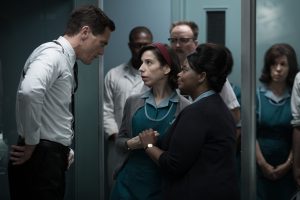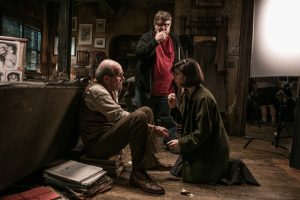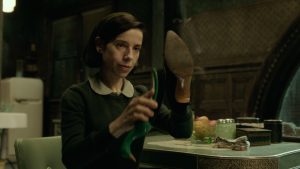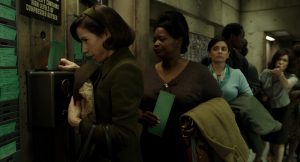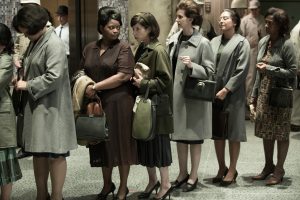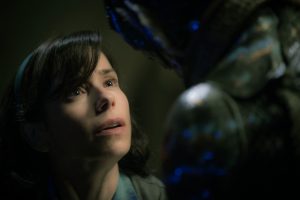December 3, 2021
by Carla Hay
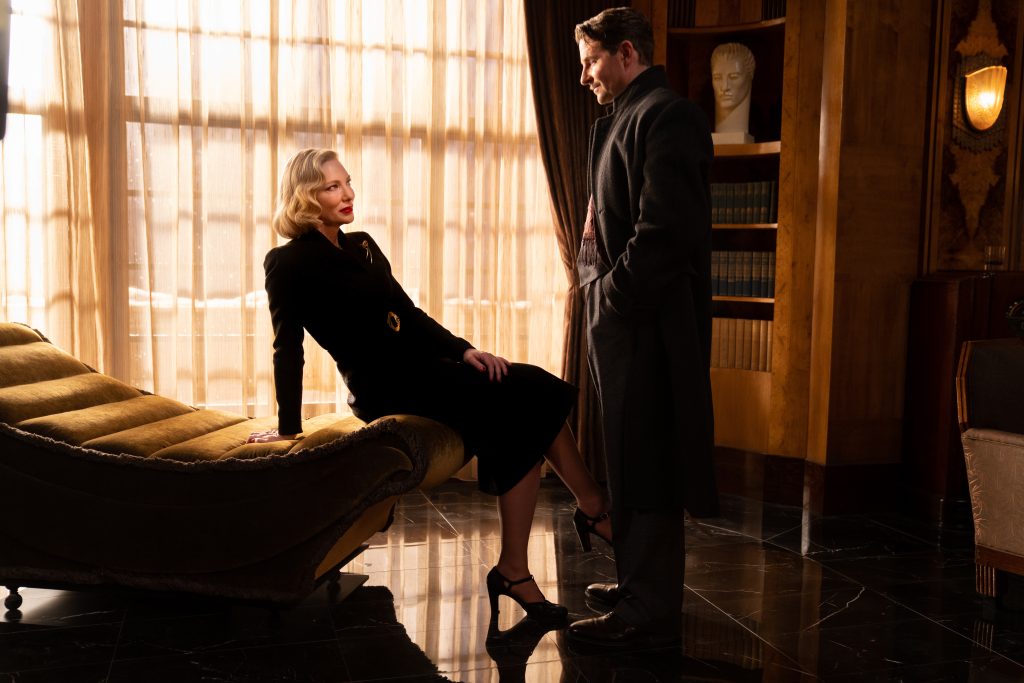
Directed by Guillermo del Toro
Culture Representation: Taking place the U.S. (including Buffalo, New York) from 1939 to the mid-1940s, the dramatic noir film “Nightmare Alley” features an almost all-white cast of characters (with one African American and one Latino) representing the working-class, middle-class and wealthy.
Culture Clash: A con man finds work at a carnival, where he learns how to use phony psychic skills to swindle people; he then leaves the carnival and teams up with a psychiatrist to con people in high society.
Culture Audience: “Nightmare Alley” will appeal primarily to fans of the movie’s star-studded cast, director Guillermo del Toro and noir dramas that are too bloated for their own good.
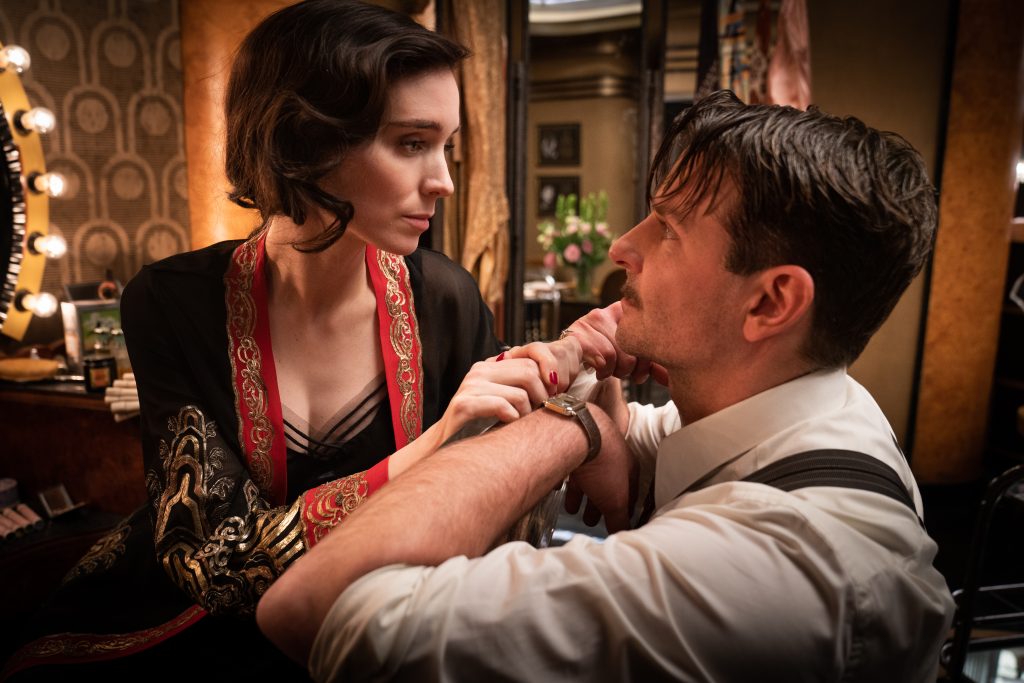
“Nightmare Alley” is a beautiful-looking noir film about many people with very ugly personalities. The movie’s production design, cinematography and costume design are impeccable. Unfortunately, the movie’s sluggish pacing, hollow characters and corny dialogue drag down this film into being a self-indulgent bore. It’s disappointing because there’s so much talent involved in making this film, but a movie like this is supposed to intrigue viewers from beginning to end, not make them feel like they want to go to sleep.
The 2021 version of “Nightmare Alley” (which clocks in at an overly long 150 minutes, or two-and-a-half hours) is a remake of director Edmund Goulding’s 1947 film “Nightmare Alley,” starring Tyrone Power, Joan Blondell, Coleen Gray and Helen Walker. The movie is based on the 1946 “Nightmare Alley” novel by William Lindsay Gresham. The 2021 version of “Nightmare Alley” is also Guillermo del Toro’s directorial follow-up to his Oscar-winning 2017 fantasy drama “The Shape of Water.” Most of the “Nightmare Alley” remake’s stars, producers and department chiefs also have Academy Award recognition, as Oscar nominees or Oscar winners. What could possibly go wrong?
For starters, all this talent cannot overcome this movie’s dreadfully dull pacing and painfully heavy-handed screenwriting that’s filled with hokey conversations. The “Nightmare Alley” remake screenplay (written by del Toro and Kim Morgan), which takes place from 1939 to the mid-1940s, lacks enough flair and nuance to bring these characters to life as well-rounded people. And fans of the original “Nightmare Alley” movie should be warned: This remake has an ending that’s much bleaker than the original movie.
In addition, better judgment should have been used in trimming parts of this movie that didn’t further the story very well. The first half of the movie takes place in a carnival, while most of the second half takes place in more upscale environments, when the central character (who’s a con artist) decides to go after wealthier targets than the type of people who go to carnivals. It seems like the filmmakers were so enamored with the elaborate production design for the carnival scenes, they overindulged in this part of the movie, which has a lot of drab dialogue and scenes with repetitive intentions.
At the world premiere of “Nightmare Alley” in New York City, producer J. Miles Dale said in an introduction on stage that the movie had been completed just two weeks before the premiere. That might explain why more thought wasn’t put into the film editing, which fails to sustain a high level of suspense and intrigue. This type of thrill is essential in a movie that pays homage to film noir of the 1940s.
And this is not a good sign: Many people at the premiere were laughing at lines that weren’t intended to be funny. (I attended the premiere, so I saw all of this firsthand.) As the movie plodded on, more and more people were checking the time on their phones, and the audience seemed to get more restless. But the bigger indication that this movie might not be as well-received as the filmmakers intended is that audience members at the premiere were openly giggling at lines of dialogue that were supposed to be dead-serious.
For example, there’s a scene where a character is physically assaulted in an attempted murder, which is thwarted when help arrives. When the character is asked how they’re feeling right after this attack, the character says in a melodramatic tone, “I’ll live.” It’s supposed to be a moment of high drama played to maximum effect, but several people were laughing because of how the scene is delivered in such a hammy way.
At the end of the movie, people in the audience politely applauded. (Keep in mind, that the audience also consisted of numerous people who worked on the film.) However, it wasn’t the kind of thunderous, standing-ovation applause that usually happens at a premiere for an award-worthy movie that’s going to be a massive, crowd-pleasing hit. Considering that there were many awards voters in the audience, this type of underwhelming response indicates that—at least for this particular premiere audience—many people weren’t that impressed with this remake of “Nightmare Alley.”
Even if the audience response had been more enthusiastic, it wouldn’t be able to cover up the movie’s problems. All of the cast members seem to be doing the best that they can, but they are often stymied by some of the trite dialogue that mostly renders them as caricatures. Very little is revealed about the characters’ backgrounds to give them a story behind their personal motivations.
Bradley Cooper (who is one of the film’s producers) portrays the lead character: Stanton “Stan” Carlisle, a con-man drifter who ends up working at a seedy traveling carnival. He starts off doing lowly odd jobs, such as helping with construction and clean-ups. But eventually, he charms his way into becoming part of the fake psychic act at the carnival.
The carnival’s psychic act is led by a married couple named Zeena Krumbein (played by Toni Collette) and Pete Krumbein (played by David Strathairn), who coordinate their act through code words, body language and hidden written prompts underneath the stage. Zeena (whose carnival nickname is The Seer) is the flamboyant “psychic” who acts and dresses like a stereotypical fortune teller. While she’s on stage, Pete is underneath the stage, where he writes information on placards that Zeena can see from where she’s standing. The information supplies the hints and codes that prompt Zeena to correctly guess personal facts about someone who gets a “psychic reading” from her.
The Krumbeins have recorded the secrets of their con game in a small journal-sized book that is mostly kept in Pete’s possession. Stan is eager to read the book, but the Krumbeins won’t let him, although they eventually divulge some of their main secrets. Although the Krumbeins have had a partnership in work and in marriage for several years, the romantic passion has left their relationship.
Pete (a former magician) has become an alcoholic, and his alcoholism has caused him to be sloppy and unreliable in his work. He might pass out during one of Zeena’s performances, which is what happens in one scene where Stan has to quickly take over for a barely coherent Pete. It’s implied that Pete has become an alcoholic because he feels guilty about conning people. At one point, Pete warns Stan that the Krumbeins’ con-game secrets should not be abused, and anyone who does so could be cursed. “No man can outrun God!” Pete says ominously.
Zeena openly has affairs with other men. And you know what that means. It isn’t long before Stan and Zeena have an affair, but it’s all lust and no love. And considering that Stan is a con artist, he has ulterior motives for getting close to Zeena. This is an example of the cornball dialogue in the movie: Zeena says this pickup line to Stan before they begin their sexual relationship: “You’re a maybe. And maybes are real bad for me.”
While Stan is carrying on an affair with Zeena, he finds himself more attracted to a virtuous young carnival worker named Molly Cahill (played by Rooney Mara), who performs as an electricity-absorbing phenomenon named Elektra. Molly’s Elektra act consists of being tied to an electric chair and absorbing shocks of voltage that could kill or injure most people. Molly has a trusting nature that makes her blind to Stan’s manipulative ways. Not much information is given about Molly’s background to explain why she’s so naïve about the “smoke and mirrors” carnival business and the con artists that this type of business attracts.
Stan and Zeena’s affair eventually fizzles out, and he begins ardently courting Molly. However, the carnival has a strong man named Bruno (played by Ron Perlman), who is very protective of Molly and is suspicious of Stan’s intentions. Bruno has a co-star named Major Mosquito (played by Mark Povinelli), who also sees himself in a patriarchal role for the carnival. Bruno’s hostility toward Stan doesn’t stop Molly from falling for Stan’s charms. Eventually, Molly and Stan become lovers.
Not much is revealed about Stan’s background except that he’s originally from Mississippi, and he has “daddy issues.” On a rare occasion that he opens up to someone about his past, he talks about a treasured watch that he has that was previously owned by Stan’s dead father. In brief flashbacks, it’s slowly revealed what Stan’s relationship with his father was like.
Meanwhile, other characters at the carnival are in the story, but they are essentially superficial clichés. The carny boss (played by Tim Blake Nelson) is a typical huckster. The carnival barker Clem Hoatley (played by Willem Dafoe) is a gruff taskmaster with a cruel and sadistic side. He likes to torment the carnival’s caged “freak” (played by Paul Anderson), a pathetic, gnarled, and dirty human being whose birth name is never revealed in the story and who is usually referred to as the Geek.
Clem tells people that the Geek can go days without food and water. The Geek doesn’t talk but instead snarls and growls like an animal. As part of the Geek’s “act,” Clem or other people feed live chickens to the Geek, who tears the chickens apart and eats them raw. Sensitive viewers should be warned that the movie shows these acts of animal cruelty in detail, through visual effects.
Cruelty and degradation (to animals and to human beings) permeate throughout “Nightmare Alley,” which is nearly devoid of any intended humor. The scenes are staged with immense attention to detail on how everything looks, but the filmmakers didn’t pay enough attention to how these characters are supposed to make viewers feel. Most of the main characters are obnoxious and/or smug, which makes it harder for viewers to root for anyone. Molly is the only character in the movie who seems immune to becoming corrupt, but she’s written as almost too good to be true.
When too many people in a movie are unlikable, that can be a problem if they’re unable to convey some shred of humanity that can make them more relatable to viewers. And the result is a movie where viewers won’t care much about the backstabbing, selfish and greedy characters that over-populate this movie. Because so many of the characters (except for Molly) are so blatant with their devious ways, there’s no suspense over who will end up double-crossing whom. And that makes almost everything so predictable.
Due to a series of circumstances, Stan ends up becoming Zeena’s partner in the fake clairvoyant act. Stan thinks that he’s got real talent for this type of con game, so he decides to run off with Molly and target wealthier “marks” so he can become rich too. Considering that Bruno is the type to get physically rough in his disapproval of Molly and Stan’s relationship, and Bruno isn’t leaving the carnival anytime soon, Stan and Molly believe the time is right to leave the carnival for a better life. Molly and Stan relocate to Buffalo, New York.
Stan then become a semi-successful solo psychic named the Great Stanton, who does his act at sleek nightclubs attended by upper-class people. Molly is his willing accomplice, as long as Stan confines his act to entertaining people as a performer who shouldn’t be taken too seriously. Stan often wears a blindfold for added effect when he makes his guesses about people, based on their body language, the way that they dress and any information he can get about the guests before the show. Stan is no longer financially struggling like he was as a carnival worker, but he wants to be as wealthy as or wealthier than the people who attend his shows. He’s about to meet his new partner his crime.
During one of his performances, Stan has a heckler in the audience who challenges his authenticity. Her name is Dr. Lilith Ritter (played by Cate Blanchett), a psychiatrist who tries to humiliate Stan by demanding that he tell everyone what is hidden in her purse. Through a series of observant deductions, Stan correctly guesses that she has a gun in her purse. He then proceeds to turn the tables on Lilith and publicly embarrass her with scathing comments for trying to prove that he’s a fraud.
Under these circumstances, any fool can see that Lilith is not the type of person to forgive and forget this public shaming. However, when Lilith invites Stan to her office, Stan readily accepts. She tells him that she knows he’s a con artist and won’t believe otherwise. Stan then admits it and tells Lilith how he figured out that she was carrying a pistol in his purse. The stage has now been set for two people who think they’re more cunning than the other, as they both try to see what they can get out of any relationship they might have.
Lilith tells Stan that she secretly records all of the sessions that she has with her patients, who are among the richest and most powerful people in the area. Stan immediately has the idea of using that information to target some of these people with his phony psychic act, by using their private information from these recorded sessions to convince them that he knows their secrets. Stan asks Lilith which of her clients is the wealthiest.
And that’s how Stan hears about ruthless business mogul Ezra Grindle (played by Richard Jenkins), who is successful when it comes to his career, but his personal life is filled with bitterness and loneliness. Ezra has confessed to Lilith that he’s been plagued with guilt over causing the death of a young woman he once loved. It’s information that Lilith and Stan use to concoct a scheme to swindle Ezra out of a fortune that they want to get in cash.
Stan and Lilith have the type of relationship where they trade insults but are sexually attracted to each other. It doesn’t take long for Stan to cheat on Molly with Lilith. Blanchett fully commits to the role of a classic noir ice queen, but her portrayal of Lilith is so transparently calculating, it’s never convincing that Lilith can be trusted in this con game that she’s agreed to with Stan.
Ezra isn’t the only “mark” who’s a target of Stan and Lilith. A well-to-do married couple named Charles Kimball (played by Peter MacNeill) and Felicia Kimball (played by Mary Steenburgen) get caught up in the deceit and fraud that Stan and Lilith have in store for them. It has to do with the Kimballs’ emotional pain over the death of their 23-year-old son Julian, who died while he was enlisted in the military. And it’s an example of how low Stan and Lilith are willing to go to exploit the death of a loved one for money.
As lead character Stan, Cooper is in almost every scene of “Nightmare Alley.” His character remains mostly an enigma because, like many con artists, he changes his persona to fit whatever perception will work to get people to do what he wants. He’s the most complex character of the movie, but his personality never comes across as genuine. Over time, Stan shows that he’s not only heartless, but he also doesn’t have much of a conscience unless he’s the one who might get hurt. He’s not even an anti-hero, although the last 10 minutes of the film try to garner some viewer sympathy for Stan.
Ezra can sense that Stan can’t be trusted, so Ezra goes back and forth with how skeptical he is when Stan tries to charm his way into Ezra’s life. However, Stan knows so many private details about Ezra, it’s enough to convince Ezra that maybe Stan is the telling the truth about being psychic. Ezra is supposed to be a brilliant businessman, but at no point is he smart enough to figure out that maybe his psychiatrist has been leaking his personal information.
Stan is supposed to be a skillful con artist, but at no point is he wise enough to figure out that if Lilith has a recording device in her office to secretly record people, maybe she would use it to secretly record Stan too. After all, the recording can be cleverly edited to leave out any incriminating things that Lilith would say. This is all just common sense, which is why it’s a bit of a slog when the movie lumbers along to make it look like there’s some kind of mystery about Lilith’s intentions. The only thing in the movie that might be considered a little unpredictable is what happens with the Kimballs.
“Nightmare Alley” is not the first retro-noir-inspired movie directed by del Toro. He also directed 2015’s “Crimson Peak” (starring Jessica Chastain, Tom Hiddleston and Mia Wasikowska), which also yielded mixed results because the pacing for the movie was so lethargic. At least “Crimson Peak” has a less tedious length of two hours. “Nightmare Alley” tries to convince people that it’s fascinating to watch monotonous scene after monotonous scene of Stan working his way up the carnival hierarchy, when the real story is what he does once he decides he’s going to become a phony psychic. The pace of the movie would’ve been better-served if about 20 to 30 minutes of the movie’s first half had been edited out.
The movie’s screenplay is still problematic though because of how it leaves no room to care about the story’s overabundance of distrustful and shallow characters, who spout a lot of words that don’t have much substance. “Nightmare Alley” takes so long to get to the inevitable end result of Stan and Lilith’s partnership, many viewers might have emotionally checked out by the time it happens. It’s enough to say that Molly is really the only character that viewers might care about by the time the movie is over. This remake’s revised ending has a well-acted, emotional final scene, but it’s not enough to make up for the character soullessness throughout most of the movie.
Searchlight Pictures will release “Nightmare Alley” in U.S. cinemas on December 17, 2021.
UPDATE: Searchlight Pictures will release a black-and-white version of “Nightmare Alley” titled “Nightmare Alley: Vision in Darkness and Light” for a limited engagement in select U.S. cinemas on January 14, 2022.











